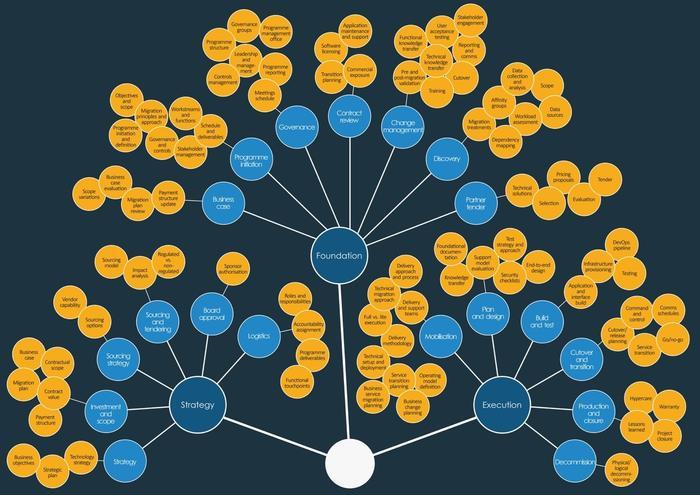A cunning plan for all future Cloud migrations
With the onslaught of new trends and innovations, organisations across every industry must evolve, adopt new ways of working and develop the skills and capabilities needed to support a Cloud-centric landscape. Start-ups joined the Cloud party from the get-go; it’s the more traditional businesses that must catch up through digital transformation if they’re to become future-fit and compete in today’s cutthroat markets. It’s a daunting prospect though, as the delivery landscape is highly complex and requires extensive governance, oversight and assurance.
Never has the need for a repeatable model that offers simplicity and control been greater.
We know every Cloud transformation programme follows a common path, so why waste time and money reinventing the wheel? The majority of the work is the same and adopting a blueprint would give organisations the means of driving successful outcomes in a consistent and controlled manner.
But a blueprint hasn’t been universally available before, and every organisation will have their own specific requirements so they need to believe something perceived as ‘generic’ will work for them. It will if it has a flexible, modular structure and is wholly agnostic, so whatever the Cloud platform (AWS, Azure, GCP etc.) and application supplier, whether regulated or unregulated, public or private sector, and whatever the scale, location or complexity, a business can be confident of success. Accepting this premise is where the early adopters will gain an advantage through ease of delivery, reduced timelines and costs.
Whether you’re using professional services or an in-house team, using this type of framework will enable you to deliver standardised outcomes that can be compared and scrutinised across your own business or other sectors and industries. And this innovative approach also extends beyond normal programme timelines as it supports the move to BAU and into a continuous improvement culture, easing future change-related pain.
Case study
A global data management organisation manages six self-governing divisions globally. One pioneer took an early decision to move to Cloud, and after five years fathoming it out themselves, learning some tough lessons and blowing a fairly hefty budget along the way, they delivered a successful migration. The Group leadership liked the result and charged the other five divisions to do the same, but with a time limit of two years and a restricted budget. It’s at this point that handing over a robust and proven blueprint looking for exactly the same results would have benefitted them individually and the company as a whole. Instead of pain, their lives would be gilded with convenience, simplicity, control, cost and resource savings, as well as a more cohesive business structure/offering overall.
Blueprint benefits
-
The technical aspects may be black or white, but a programme is not all binary. Taking a holistic view and integrating every key component is the only way to assure the successful outcome you want, and knowing exactly what needs to be included has to be the first step. This is where a blueprint comes into its own; it will help your organisation define and understand your business objectives, strategic imperatives and desired outcomes, and what part everyone needs to play.

-
A blueprint enables you to prepare for tomorrow, not today. It’s critical to tick every box to satisfy the Board, shareholders, business users and auditors particularly when the cost and business impact of a migration programme is so significant. Integrating the technical with the non-technical components and underpinning it all with robust management and governance delivers the confidence they need.
-
Whether integrating business and technical strategies, identifying benefits/ROI, selecting vendors, reviewing contracts, re-designing your delivery organisation, planning a technical migration or designing a transition to BAU, a blueprint will guide you throughout, assuring the health of your programme, its timings and costs.
-
A blueprint offers flexibility and can be used on a net-new programme or as a hurt and rescue package if you’re already on the journey, but everything has come to grinding halt. After all, how do you know what’s right if you don’t know what’s wrong? A blueprint will help your team regain control with renewed confidence, to oversee, manage and assure the successful delivery of your programme. And if your professional services supplier is faltering, you can use it to inform yourselves, hold their feet to the fire, and let them know what you’re expecting from them, and when.
“If you fail to plan, you are planning to fail.” Benjamin Franklin wasn’t necessarily talking about the future of Cloud migrations, but he was still right on the money.
Author:
Aitemology® is the creator of a unique methodology (aitemology®) that forms the basis of the digital and business transformation Plug and Playbook series (Cloud, Change, Consult etc.). Consisting of a ‘how to’ primer underpinned by a large number of specific/dedicated aitems® (policies, processes, technical products, reports, templates), organisations are able to follow their chosen transformation process step by step from start to finish (including all technical and non-technical elements) with convenience, clarity and control.

Laura Foster
Laura is techUK’s Associate Director for Technology and Innovation.


